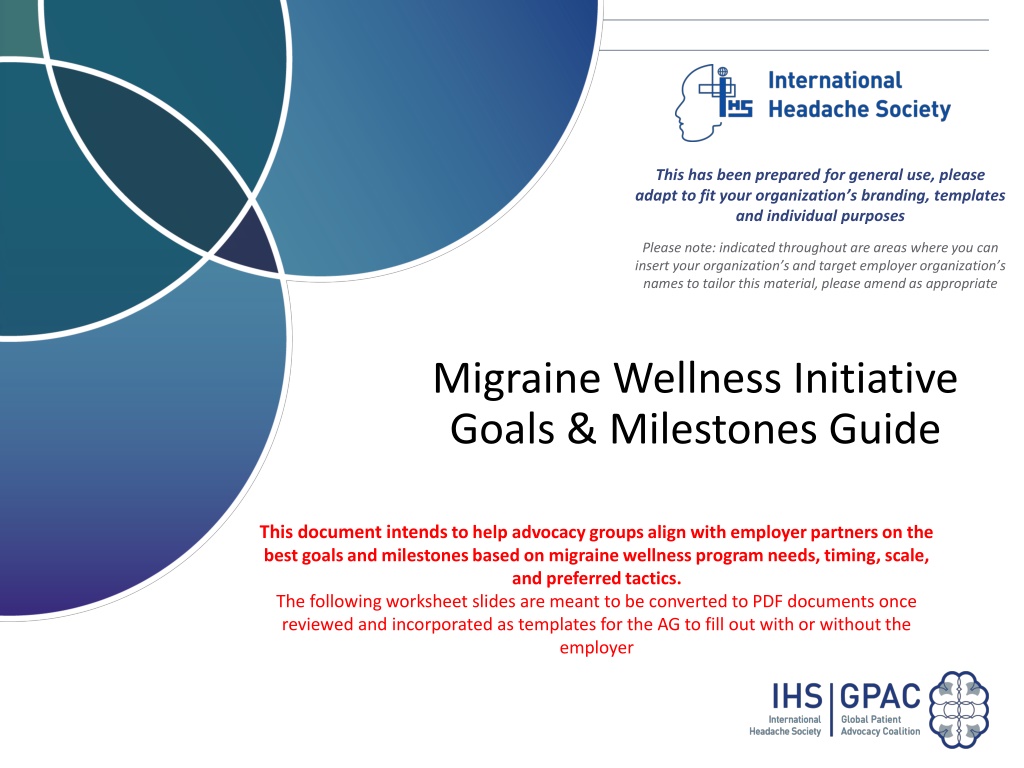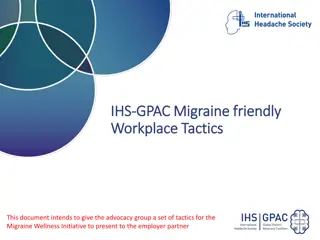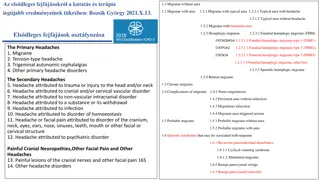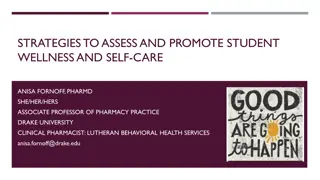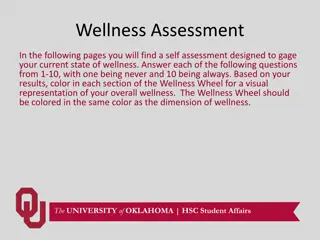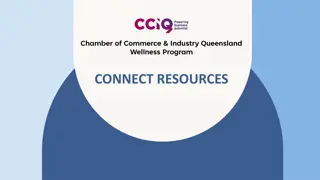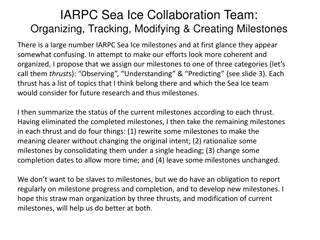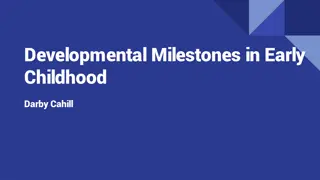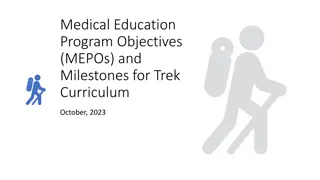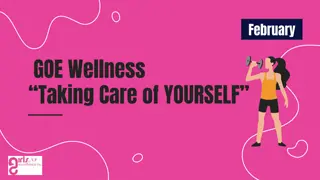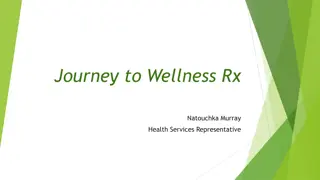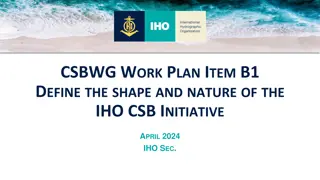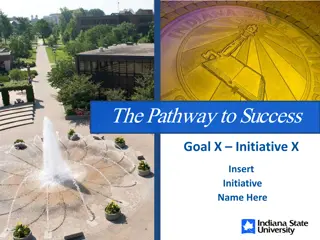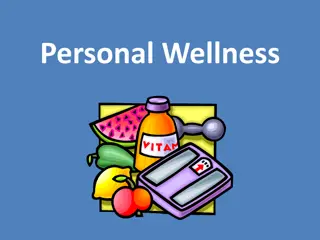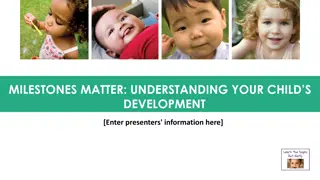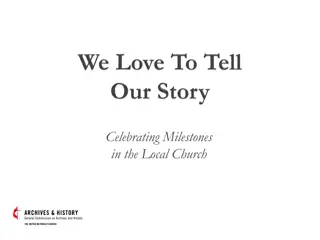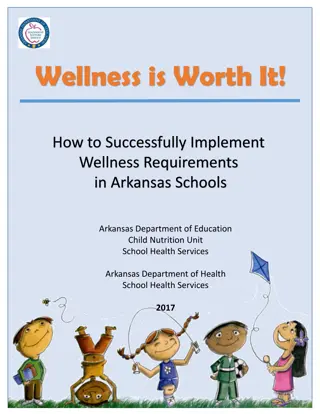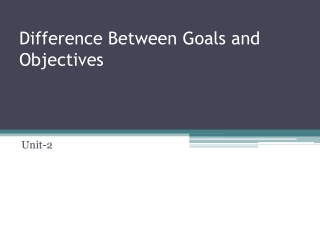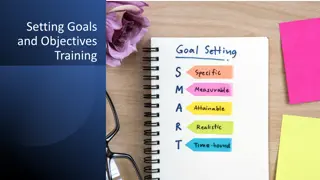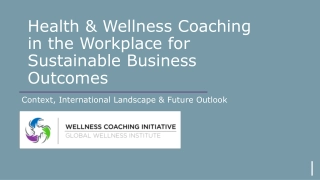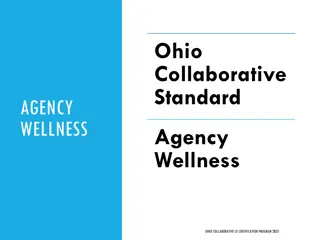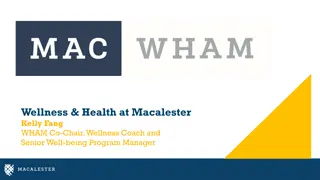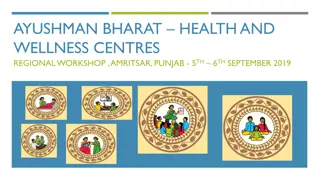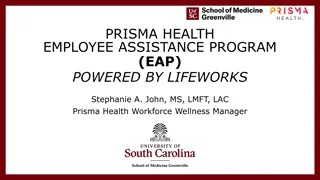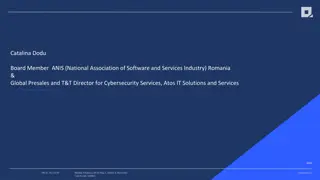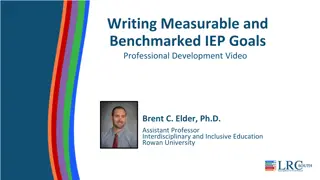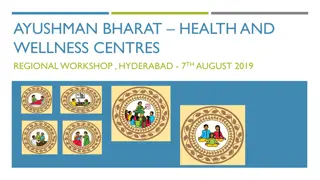Migraine Wellness Initiative Goals & Milestones Guide
This guide aims to assist advocacy groups in aligning with employer partners to achieve the best goals and milestones for migraine wellness programs, emphasizing the importance of setting, achieving, and evaluating these objectives through a structured process.
Download Presentation

Please find below an Image/Link to download the presentation.
The content on the website is provided AS IS for your information and personal use only. It may not be sold, licensed, or shared on other websites without obtaining consent from the author. Download presentation by click this link. If you encounter any issues during the download, it is possible that the publisher has removed the file from their server.
E N D
Presentation Transcript
This has been prepared for general use, please adapt to fit your organization s branding, templates and individual purposes Please note: indicated throughout are areas where you can insert your organization s and target employer organization s names to tailor this material, please amend as appropriate Migraine Wellness Initiative Goals & Milestones Guide This document intends to help advocacy groups align with employer partners on the best goals and milestones based on migraine wellness program needs, timing, scale, and preferred tactics. The following worksheet slides are meant to be converted to PDF documents once reviewed and incorporated as templates for the AG to fill out with or without the employer
Goal & milestone guidance overview Goal & milestone guidance overview This document provides suggestions for each tactic in the initiative Why goals and milestones are important What goals and milestones are important How to achieve the goals and milestones Navigation Icons Refer to these icons for additional program management tips related to potential roadblocks RESOURCES ALIGNMENT MANPOWER PARTICIPATION 2
Goal & milestone planning document instructions Goal & milestone planning document instructions How to use this document Information road signs will appear on slides that show how to use specific slides within this document Instructions Information road signs will appear on slides that will have general details around the wellness initiative that will be useful for goal and milestone* planning * are noted in some of the slides the * refers to a word or phrase defined in the glossary of terms Information * are noted in some of the slides the * refers to a word or phrase defined in the glossary of terms Worksheet road signs will appear on slides that can be filled to visualize program goal and milestone planning Worksheet Takeaway bars appear on slides and contain further advice or instructions to consider
Information Information Table of contents Table of contents Goals & milestones planning timelines Workplace initiative proposed timeline Workplace initiative proposed timeline details Content map for goals and milestones Road map for goals and milestones Sharing goals of the advocacy group with the employer partner Evaluation of resources for goals SWOT Analysis Determining milestones Final alignment for goals, milestones, metrics, and tactics Glossary of terms
Goal & milestone planning timelines Goal & milestone planning timelines Workplace Initiative Proposed Timeline Workplace Initiative Proposed Timeline Migraine Initiative Implementation Form Collaborative Agreement Migraine Impact Assessment 1 5 3 Work with experts and appropriate wellness providers to rollout initiative, monitoring success and develop record best practices Develop collaborative agreement with [insert employer s name] to enable [insert your organization s name] to tailor a program with meaningful change for employees impacted by migraine in the organization Establish true impact of migraine burden and stigma in the workplace leveraging [insert employer s name] previous work, desk research and any additional data collected by [insert employer s name] End of Initiative Initiative Midpoint Start date 2 4 6 Deep Understanding of Disease Burden Initiative Development Toolkit Value Assessment Through focus group sessions with employees and company leadership, co-create an impactful bespoke migraine wellness program with best practices, rollout roadmap and success KPIs Understand employee journey in the workplace through research work and discussion with employees impacted by migraine and company leadership, to develop an employee journey map Assess the design, development and implementation of wellness programs leveraging the employer toolkit as a primary guide 5
Information Information Table of contents Table of contents Goals & milestones planning timelines Workplace initiative proposed timeline Workplace initiative proposed timeline details Content map for goals and milestones Road map for goals and milestones Sharing goals of the advocacy group with the employer partner Evaluation of resources for goals SWOT Analysis Determining milestones Final alignment for goals, milestones, metrics, and tactics Glossary of terms
Goal & milestone planning timelines Goal & milestone planning timelines Workplace initiative proposed timeline details Migraine Initiative Implementation What should you do during the collaborative agreement phase? Form Collaborative Agreement Migraine Impact Assessment Use the General employer proposal deck to show the employer partner what the plans for the program will be and how impactful the wellness initiative can be on employees 1 5 3 Work with experts and appropriate wellness providers to rollout initiative, monitoring success and develop record best practices Develop collaborative agreement with [insert employer s name] to enable [insert your organization s name] to tailor a program with meaningful change for employees impacted by migraine in the organization Establish true impact of migraine burden and stigma in the workplace leveraging [insert employer s name] previous work, desk research and any additional data collected by [insert employer s name] Will allow for advocacy group to share the goals of the program while allowing for the employer partner to make customizations related to their company culture Why should you have a collaborative agreement phase? End of Initiative Initiative Midpoint Start date Will allow you to provide background information on what you will be offering the employer 2 4 6 Deep Understanding of Disease Burden Initiative Development What is the value added to the employer partner during this phase? Toolkit Value Assessment Through focus group sessions with employees and company leadership, co-create an impactful bespoke migraine wellness program with best practices, rollout roadmap and success KPIs Employer partner will be able to ask questions around the program and share concerns, if any exist. Understand employee journey in the workplace through research work and discussion with employees impacted by migraine and company leadership, to develop an employee journey map Assess the design, development and implementation of wellness programs leveraging the employer toolkit as a primary guide 7
Goal & milestone planning timelines Goal & milestone planning timelines Workplace initiative proposed timeline details What should you do during the disease burden phase? Migraine Initiative Implementation Form Collaborative Agreement Migraine Impact Assessment Use this information to determine which tactics may be useful to implement Understand the work culture and employee concerns in the workplace 1 5 3 Work with experts and appropriate wellness providers to rollout initiative, monitoring success and develop record best practices Develop collaborative agreement with [insert employer s name] to enable [insert your organization s name] to tailor a program with meaningful change for employees impacted by migraine in the organization Establish true impact of migraine burden and stigma in the workplace leveraging [insert employer s name] previous work, desk research and any additional data collected by [insert employer s name] Also understand why employees would participate in specific tactics Why should you have a disease burden phase? Will allow for advocacy group to establish a relationship with the employees that will be participating in the program End of Initiative Initiative Midpoint Start date What is the value added to the employer partner during this phase? Employer partner will be able to contextualize the migraine burden that is truly present within their organization 2 4 6 Deep Understanding of Disease Burden Initiative Development Toolkit Value Assessment Through focus group sessions with employees and company leadership, co-create an impactful bespoke migraine wellness program with best practices, rollout roadmap and success KPIs Note: Discussions may need to be anonymous and research work may need to de-identified if permitted Understand employee journey in the workplace through research work and discussion with employees impacted by migraine and company leadership, to develop an employee journey map Assess the design, development and implementation of wellness programs leveraging the employer toolkit as a primary guide
Goal & milestone planning timelines Goal & milestone planning timelines Workplace initiative proposed timeline details Migraine Initiative Implementation Form Collaborative Agreement Migraine Impact Assessment 1 1 5 3 What should you do during the migraine impact assessment phase? Work with experts and appropriate wellness providers to rollout initiative, monitoring success and develop record best practices Develop collaborative agreement with [insert employer s name] to enable [insert your organization s name] to tailor a program with meaningful change for employees impacted by migraine in the organization it will provide data around migraine in the workplace prior to the initiation of the migraine wellness initiative Establish true impact of migraine burden and stigma in the workplace leveraging [insert employer s name] previous work, desk research and any additional data collected by [insert employer s name] Gather data surrounding migraine in the workplace from research provided by the employer partner Utilize the migraine impact tool tactic, as End of Initiative Initiative Midpoint Start date Why should you have a migraine impact assessment phase? 2 4 6 Deep Understanding of Disease Burden To understand the depth of the program to be developed Initiative Development Toolkit Value Assessment To understand the potential impact that migraine is having on employees Through focus group sessions with employees and company leadership, co-create an impactful bespoke migraine wellness program with best practices, rollout roadmap and success KPIs Understand employee journey in the workplace through research work and discussion with employees impacted by migraine and company leadership, to develop an employee journey map this phase? Employer partner can establish the migraine burden within their organization and employee investments that could be made Assess the design, development and implementation of wellness programs leveraging the employer toolkit as a primary guide What is the value added to the employer partner during
Goal & milestone planning timelines Goal & milestone planning timelines Workplace initiative proposed timeline details Migraine Initiative Implementation Form Collaborative Agreement Present the all relevant tactics to employer partner based on previous information Migraine Impact Assessment 1 5 3 What should you do during the initiative development phase? Work with experts and appropriate wellness providers to rollout initiative, monitoring success and develop record best practices Develop collaborative agreement with [insert employer s name] to enable [insert your organization s name] to tailor a program with meaningful change for employees impacted by migraine in the organization Establish true impact of migraine burden and stigma in the workplace leveraging [insert employer s name] previous work, desk research and any additional data collected by [insert employer s name] Consider goals and milestones that should be assessed based on tactics Why should you have a migraine initiative development phase? Determine which tactics will be utilized and when Create a rollout plan, including goals and milestones for each tactic End of Initiative Initiative Midpoint Start date 2 4 6 What is the value added to the Deep Understanding of Disease Burden employer partner during this phase? Initiative Development Toolkit Value Assessment Through focus group sessions with employees and company leadership, co-create an impactful bespoke migraine wellness program with best practices, rollout roadmap and success KPIs Understand employee journey in the workplace through research work and discussion with employees impacted by migraine and company leadership, to develop an employee journey map Employer partner can allocate budgets for programs, if available Assess the design, development and implementation of wellness programs leveraging the employer toolkit as a primary guide Employer partner can determine the scale, and timeliness for program initiation Goal and milestone sharing is within this stage
Goal & milestone planning timelines Goal & milestone planning timelines Workplace initiative proposed timeline details Migraine Initiative Implementation Form Collaborative Agreement Assign tasks to employer operational team* & initiate roll-out of each tactic Migraine Impact Assessment What should you do during the migraine initiative implementation phase? 1 1 5 3 3 Work with experts and appropriate wellness providers to rollout initiative, monitoring success and develop record best practices Develop collaborative agreement with [insert employer s name] to enable [insert your organization s name] to tailor a program with meaningful change for employees impacted by migraine in the organization This is the key phase in the initiative as it will establish each tactic Establish true impact of migraine burden and stigma in the workplace leveraging [insert employer s name] previous work, desk research and any additional data collected by [insert employer s name] Determine who will monitor tactics and how Why should you have a migraine initiative implementation phase? End of Initiative Initiative Midpoint Start date What is the value added to the employer partner during this phase? This phase is the initial step in program success, employer partners can provide suggestions for future roll-outs, monitoring, and other activities for streamlined and successful implementation 2 4 6 Deep Understanding of Disease Burden Initiative Development Toolkit Value Assessment Through focus group sessions with employees and company leadership, co-create an impactful bespoke migraine wellness program with best practices, rollout roadmap and success KPIs Understand employee journey in the workplace through research work and discussion with employees impacted by migraine and company leadership, to develop an employee journey map Assess the design, development and implementation of wellness programs leveraging the employer toolkit as a primary guide
Goal & milestone planning timelines Goal & milestone planning timelines Workplace initiative proposed timeline details Migraine Initiative Implementation Form Collaborative Agreement Think about what worked best for your advocacy group and report back to IHS-GPAC Migraine Impact Assessment What should you do during the toolkit value assessment phase? 1 1 5 5 3 3 Work with experts and appropriate wellness providers to rollout initiative, monitoring success and develop record best practices Develop collaborative agreement with [insert employer s name] to enable [insert your organization s name] to tailor a program with meaningful change for employees impacted by migraine in the organization participate because of hearing about your positive experiences Establish true impact of migraine burden and stigma in the workplace leveraging [insert employer s name] previous work, desk research and any additional data collected by [insert employer s name] Why should you have a toolkit value assessment phase? Sharing success stories about using these tools can help migraine wellness initiatives gain momentum globally more advocacy groups may choose to Feedback to IHS-GPAC will help improve the toolkit based on your feedback End of Initiative Initiative Midpoint Start date What is the value added to the employer partner during this phase? Employer partners will have the benefit of being positioned as forward-thinking pioneers in global migraine wellness 2 4 6 Deep Understanding of Disease Burden Initiative Development Toolkit Value Assessment Through focus group sessions with employees and company leadership, co-create an impactful bespoke migraine wellness program with best practices, rollout roadmap and success KPIs Understand employee journey in the workplace through research work and discussion with employees impacted by migraine and company leadership, to develop an employee journey map Assess the design, development and implementation of wellness programs leveraging the employer toolkit as a primary guide
Information Information Table of contents Table of contents Goals & milestones planning timelines Workplace initiative proposed timeline Workplace initiative proposed timeline details Content map for goals and milestones Road map for goals and milestones Sharing goals of the advocacy group with the employer partner Evaluation of resources for goals SWOT Analysis Determining milestones Final alignment for goals, milestones, metrics, and tactics Glossary of terms
Information Information Content map for goals and milestones Content map for goals and milestones This document has been developed as a supporting material to facilitate goal sharing and milestone development with your target employer organization Section 1: Sharing goals with the employer partner This section will cover the goals for each tactic The employer partner will need to understand what the outcome will be for each tactic and what will be used to show that the program was successful The employer partner can comment on whether their goals align with those presented for the advocacy group to keep in mind while monitoring program outcomes Section 2: Determining the resources needed to meet goals This section will include worksheets to determine what the advocacy group and the employer partner can allocate Determining which resources are needed and which are already in place will guide the planning process The employer partner can devote potential resources or ask the advocacy group to plan to allocate more of their own resources (i.e. # of volunteers, time needed, staffing from employer partner) Section 3: Presenting milestones to track goals This section will present which milestones and metrics can be used to evaluate whether goals are on track Milestones provide valuable insights; if milestones are not met, perhaps there should be a change in the program The employer partner can visualize potential success when milestones are met Section 4: Final alignment - putting it all together This section provides a template to align goals with tactics, milestones, metrics, evidence, and outcomes to present The final alignment helps visualize the program with all the pieces that were discussed previously The employer partner can refer back to this template when questions arise around any of evidence for success
Information Information Table of contents Table of contents Goals & milestones planning timelines Workplace initiative proposed timeline Workplace initiative proposed timeline details Content map for goals and milestones Road map for goals and milestones Sharing goals of the advocacy group with the employer partner Evaluation of resources for goals SWOT Analysis Determining milestones Final alignment for goals, milestones, metrics, and tactics Glossary of terms
Information Information Road map for goals & milestones development Road map for goals & milestones development The following slide provides a stepwise approach to aligning on goals & milestones with a partner employer Follow the content map to present the goals for each tactic, discuss resources needed to achieve them, and finally create a plan for the initiative STEP 5 STEP 4 Finalize approach to program development based on goals developed in final alignment template STEP 3 Customize which metrics can be used to track milestones and goals throughout program progression STEP 2 Perform SWOT Analysis (advocacy group only) STEP 1 Evaluate resources required for program based on goals Share goals of the advocacy group with the employer partner More details around each step will be covered in future slides
Information Information Table of contents Table of contents Goals & milestones planning timelines Workplace initiative proposed timeline Workplace initiative proposed timeline details Content map for goals and milestones Road map for goals and milestones Sharing goals of the advocacy group with the employer partner Evaluation of resources for goals SWOT Analysis Determining milestones Final alignment for goals, milestones, metrics, and tactics Glossary of terms
Road map for goal & milestone development: sharing goals of the advocacy group with the employer partner Road map for goal & milestone development: sharing goals of the advocacy group with the employer partner Sharing goals with the employer partner can help the employer partner understand Sharing goals with the employer partner can help the employer partner understand the program outcomes the program outcomes Why is goal setting important? Goal setting can help align the advocacy group and employer partner on which program tactics are best to initiate, in order to reach the desired outcomes STEP 5 STEP 4 Finalize approach to program development based on goals developed in final alignment template Customize which metrics can be used to track milestones and goals throughout program progression STEP 3 Perform SWOT Analysis (advocacy group only) STEP 2 STEP 1 Evaluate resources required for program based on goals Share goals of the advocacy group with the employer partner
Road map for goal & milestone development: sharing goals of the advocacy group with the employer partner Road map for goal & milestone development: sharing goals of the advocacy group with the employer partner What are the goals for each tactic? What are the goals for each tactic? Outcomes Goals based on tactics Migraine Awareness Webinars Workplace Awareness Posters Increase awareness of migraine amongst all employees through a series of short and engaging webinars given by healthcare professionals and/or patients Encourage empathy of all employees with those affected by migraine through a series of informational posters in the workplace Migraine Awareness Migraine Impact Assessment Lunch and Learn / Migraine Caf Leverage the migraine and headache impact tool to enhance employees understanding of their condition and possible need for improved care Provide a forum and learning opportunities for employees to engage with senior management, patients and experts to discuss migraine over a meal Migraine Education Decreased absenteeism Increased productivity Overall program outcomes 19
Road map for goal & milestone development: sharing goals of the advocacy group with the employer partner Road map for goal & milestone development: sharing goals of the advocacy group with the employer partner Once goals are shared, the advocacy group can begin to think about how to achieve Once goals are shared, the advocacy group can begin to think about how to achieve them through various tactics them through various tactics What should you do with the goals that have been shared by the advocacy group to the employer partner? STEP 5 Begin to evaluate how to best leverage the available tactics to drive impact Finalize approach to program development based on goals developed in final alignment template STEP 4 Customize which metrics can be used to track milestones and goals throughout program progression STEP 3 STEP 2 Perform SWOT Analysis (advocacy group only) STEP 1 Evaluate resources required for program based on goals Share goals of the advocacy group with the employer partner
Information Information Table of contents Table of contents Goals & milestones planning timelines Workplace initiative proposed timeline Workplace initiative proposed timeline details Content map for goals and milestones Road map for goals and milestones Sharing goals of the advocacy group with the employer partner Evaluation of resources for goals SWOT Analysis Determining milestones Final alignment for goals, milestones, metrics, and tactics Glossary of terms
Road map for goal & milestone development: evaluation of resources for goals Road map for goal & milestone development: evaluation of resources for goals Based on the goals of the migraine wellness initiative, begin thinking about what is required from both the advocacy group and the employer partner to support the initiative Why is it important to think about the resources required by everyone involved in the program? In order to successfully organize and monitor the migraine wellness initiative, it is important to understand what is required of the advocacy group to support the program and of the employer partner Establishing open communication between what is available and what is not can help set expectations around resources for everyone involved and help design the program accordingly STEP 5 Finalize approach to program development based on goals developed in final alignment template STEP 4 Customize which metrics can be used to track milestones and goals throughout program progression STEP 3 STEP 2 Perform SWOT Analysis (advocacy group only) STEP 1 Evaluate resources required for program based on goals Share goals of the advocacy group with the employer partner Worksheets A and B are included to evaluate resources
Road map for goal & milestone development: evaluation of resources for goals Road map for goal & milestone development: evaluation of resources for goals Worksheet A What resources* are required from the Advocacy Group to meet their goals? Based on each goal, use this worksheet to determine what the advocacy group can allocate to the program. Think about costs, volunteers, and time. Determine with the employer partner if it feasible to acquire the needed resources. Note: resources can vary based on scale and timeliness. [Insert goal to be evaluated] Ability to Acquire Resources (Y/N) How to Acquire Needed Resources Resources Needed to Acquire AG Resources Available Use this to plan what is available to the advocacy group (i.e. volunteers, budget for initiative, general funding, etc) based on the goals discussed previously.
Road map for goal & milestone development: evaluation of resources for goals Road map for goal & milestone development: evaluation of resources for goals Worksheet B What resources are required from the Employer Partner to meet their goals? Based on each goal, use this worksheet to determine what the employer partner can allocate to the program. Ask direct questions about budgets, staffing, and timeliness. Determine with the employer partner if it feasible to acquire resources. Note: resources can vary based on scale and timeliness. [Insert goal to be evaluated] Willingness to Acquire Resources (Y/N) How to Acquire Needed Resources Employer Resources Available Resources Needed to Acquire Use this to plan what is available to [Target Employer], determine if potential fundraising is needed, determine tactics based on resources and/or willingness to acquire resources
Road map for goal & milestone development: evaluation of resources for goals Road map for goal & milestone development: evaluation of resources for goals After resources are discussed, it is important to follow up on what resources the employer partner can allocate and what resources the advocacy group has to adjust to manage the program scale and costs accordingly Smaller scale initiatives may require less resources Larger scale initiatives may require most resources STEP 5 Finalize approach to program development based on goals developed in final alignment template STEP 4 Customize which metrics can be used to track milestones and goals throughout program progression STEP 3 STEP 2 Perform SWOT Analysis (advocacy group only) employer partner around the resources that have been acquired, as well as anything that cannot be acquired After identifying what is required for a successful initiative, what should you do with this information? Have open communication between the advocacy group and the STEP 1 Evaluate resources required for program based on goals Share goals of the advocacy group with the employer partner Discuss any strategies for obtaining the necessary resources, as well as how soon they can be acquired by each party this will likely affect the scale and timeline for the initiative
Information Information Table of contents Table of contents Goals & milestones planning timelines Workplace initiative proposed timeline Workplace initiative proposed timeline details Content map for goals and milestones Road map for goals and milestones Sharing goals of the advocacy group with the employer partner Evaluation of resources for goals SWOT Analysis Determining milestones Final alignment for goals, milestones, metrics, and tactics Glossary of terms
Road map for goal & milestone development: SWOT analysis Road map for goal & milestone development: SWOT analysis Utilize the SWOT Analysis* to review resources that the advocacy group may already have as well as well as what parts of the group can improve What is a SWOT analysis? A SWOT analysis can help identify any internal and external factors that can impact the advocacy group throughout the migraine wellness initiative It can help set the focus and aim of the scale of the initiative for your advocacy group STEP 5 Why is the SWOT analysis important? Proactively identifying these factors can help improve the overall success of the advocacy group Gaining insight into your advocacy group can show where the group can improve, as well as what strengths can be utilized during the Finalize approach to program development based on goals developed in final alignment template STEP 4 Customize which metrics can be used to track milestones and goals throughout program progression initiative STEP 3 STEP 2 Perform SWOT Analysis (advocacy group only) STEP 1 Evaluate resources required for program based on goals Share goals of the advocacy group with the employer partner Example to follow and worksheet C included to guide the SWOT analysis
Road map for goal & milestone development: SWOT analysis Road map for goal & milestone development: SWOT analysis SWOT Analysis SWOT Analysis Use this example template to gather ideas of things to analyze with the advocacy group Weaknesses* Strengths* -Include items that your group is lacking or needs to find -Include items that your group does well -Members (i.e. HCPs or just that your group needs more volunteers) -Skills of members (HCPs? Connected to employers? Management -Resources (i.e. budgets, transportation availability, spaces) skills?) -Resources (i.e. budgets, transportation availability, spaces) Threats* Opportunities* -What obstacles exist for the initiative and/or group? -What are the goals of the group in general? -Lack of employer partners/low openness to wellness programs or your initiative -What are the goals of the group for the initiative? -How many employer partners are in your area/how many are willing to work with you? -Culture does not favor wellness initiatives/migraine wellness -What is the culture in your area toward migraine/wellness programs? -What external sources for help do you have? Determine what the group can leverage internally before outsourcing for help in implementing the initiative and meeting with the [Employer Partner]. Discuss advocacy group resources and how they fit into goal achievement and tactic selection
Road map for goal & milestone development: SWOT analysis Road map for goal & milestone development: SWOT analysis Worksheet C SWOT Analysis SWOT Analysis Use this example template to gather ideas of things to analyze with the advocacy group Weaknesses* Strengths* Threats* Opportunities* Determine what the group can leverage internally before outsourcing for help in implementing the initiative and meeting with the [Employer Partner]. Discuss advocacy group resources and how they fit into goal achievement and tactic selection
Road map for goal & milestone development: SWOT analysis Road map for goal & milestone development: SWOT analysis After going through the SWOT Analysis, utilize the information to improve identified After going through the SWOT Analysis, utilize the information to improve identified weaknesses, minimize threats, and leverage strengths and opportunities to help weaknesses, minimize threats, and leverage strengths and opportunities to help manage the migraine wellness initiative and shape development manage the migraine wellness initiative and shape development What should you do after the SWOT Analysis is complete? Once factors from the analysis have been identified, keep them in mind while choosing tactics, setting meetings, committing time, and gathering support for the initiative, as well as the advocacy group as a whole STEP 5 Finalize approach to program development based on goals developed in final alignment template STEP 4 Customize which metrics can be used to track milestones and goals throughout program progression STEP 3 STEP 2 Perform SWOT Analysis (advocacy group only) STEP 1 Evaluate resources required for program based on goals Share goals of the advocacy group with the employer partner
Information Information Table of contents Table of contents Goals & milestones planning timelines Workplace initiative proposed timeline Workplace initiative proposed timeline details Content map for goals and milestones Road map for goals and milestones Sharing goals of the advocacy group with the employer partner Evaluation of resources for goals SWOT Analysis Determining milestones Final alignment for goals, milestones, metrics, and tactics Glossary of terms
Road map for goal & milestone development: determining milestones Road map for goal & milestone development: determining milestones Based on the goals and tactics that the employer partner wants, determine which metrics will be tracked to reach milestones What are metrics? Metrics are measurements that can be used to track and assess progress toward milestones, followed by a goals STEP 5 Finalize approach to program development based on goals developed in final alignment template STEP 4 Customize which metrics can be used to track milestones and goals throughout program progression STEP 3 STEP 2 Perform SWOT Analysis (advocacy group only) STEP 1 Evaluate resources required for program based on goals Share goals of the advocacy group with the employer partner
Road map for goal & milestone development: determining milestones Road map for goal & milestone development: determining milestones What metrics should track each tactic? What metrics should track each tactic? Outcomes Potential metrics to track based on tactics Migraine Awareness Webinars Workplace Awareness Posters Attendance at webinars Engagement measured through participation Employee feedback rating scales Migraine Awareness Employee feedback rating scales Migraine Impact Assessment Lunch and Learn / Migraine Caf Attendance at lunch & learns Engagement measured through participation Employee feedback rating scales Migraine Education Number of completed surveys Employee feedback rating scales 33
Road map for goal & milestone development: determining milestones Road map for goal & milestone development: determining milestones After milestones are selected, think about which metrics are important for tracking After milestones are selected, think about which metrics are important for tracking them them What are milestones? They are important achievements while moving toward initiative completion They can help the advocacy group show the employer partner how the program is going STEP 5 Finalize approach to program development based on goals developed in final alignment template STEP 4 Customize which metrics can be used to track milestones and goals throughout program progression STEP 3 STEP 2 Perform SWOT Analysis (advocacy group only) STEP 1 Evaluate resources required for program based on goals Share goals of the advocacy group with the employer partner
Road map for goal & milestone development: determining milestones Road map for goal & milestone development: determining milestones What are the milestones for each tactic? What are the milestones for each tactic? Overall milestones for program Outcomes Potential milestones based on tactics Migraine Awareness Webinars Workplace Awareness Posters Program enrollment among all invited employees Foot traffic around each poster site Migraine Awareness Awareness at start, midpoint, and end of program (i.e. 0%, 50%, 100%, respectively, awareness among employees) Rate of online seminar participation by enrolled employees Number of employees rating the program as valuable when gathering feedback Number of employees rating the program as valuable when gathering feedback Migraine Impact Assessment Lunch and Learn / Migraine Caf Percent of employees recognizing symptoms and taking action in response to migraine at start, midpoint, and end of program (0%, 50%, 100%) Number of employees opening the email with assessment Program enrollment among all invited employees Migraine Education Number of employees visiting the assessment portal Rate of participation by enrolled employees Number of employees completing assessment Percent of employees responding to colleagues with migraine at start, midpoint, and end of program (0%, 50%, 100%) Number of employees rating the program as valuable when gathering feedback Number of employees rating the program as valuable when gathering feedback 35
Information Information Table of contents Table of contents Goals & milestones planning timelines Workplace initiative proposed timeline Workplace initiative proposed timeline details Content map for goals and milestones Road map for goals and milestones Sharing goals of the advocacy group with the employer partner Evaluation of resources for goals SWOT Analysis Determining milestones Final alignment for goals, milestones, metrics, and tactics Glossary of terms
Road map for goal & milestone development: final alignment for goals, milestones, metrics, and tactics Road map for goal & milestone development: final alignment for goals, milestones, metrics, and tactics Once goals and milestones have been shared with the employer partner, put is all together for everyone to align on and visualize Why is important to discuss the final alignment with the employer partner? Confirm all of the goals with the employer partner will help determine tactics Creating a final alignment will help plan out the initiative and begin mapping out specific metrics to measure STEP 5 Finalize approach to program development based on goals developed in final alignment template STEP 4 Customize which metrics can be used to track milestones and goals throughout program progression STEP 3 STEP 2 Perform SWOT Analysis (advocacy group only) STEP 1 Evaluate resources required for program based on goals Share goals of the advocacy group with the employer partner Worksheet D included to guide the final alignment exercise
Road map for goal & milestone development: final alignment for goals, milestones, metrics, and tactics Road map for goal & milestone development: final alignment for goals, milestones, metrics, and tactics Based on chosen tactics select what outcomes, milestones, and metrics tactics select what outcomes, milestones, and metrics will be monitored, and how often; show this to the employer partner as a visual depiction how often; show this to the employer partner as a visual depiction of the program of the program Overall outcomes* Tactic* Metrics Milestones Monitoring Determine based on employer needs, which tactics will be implemented What will be the desired outcome based on program tactics What milestones will be utilized & reviewed periodically How often will each tactic be observed, think about effort required to do so How will you measure milestones Refer to glossary for * information around * terms Refer to glossary for * information around * terms 38
Road map for goal & milestone development: final alignment for goals, milestones, metrics, and tactics Road map for goal & milestone development: final alignment for goals, milestones, metrics, and tactics The following table presents a list of information found previously in this document, but in a format that will put it all together to visualize. Utilize the table with tactics chosen for the employer partner and select which the advocacy group will track in the following slide Tactic* Overall outcomes* Metrics* Milestones Monitoring Refer to the milestone slide for overall program milestones to include Foot traffic around each poster site Increase in productivity Employee feedback rating scales Awareness posters Number of employees rating the program as valuable when gathering feedback Decrease in Absenteeism Program enrollment among all invited employees Attendance at webinars Increase in productivity Rate of online seminar participation by enrolled employees Engagement measured through participation Webinars Employee feedback rating scales Decrease in Absenteeism Number of employees rating the program as valuable when gathering feedback Utilize the meeting check-in guidelines document for further assistance around monitoring Number of employees opening the email with assessment Increase in productivity Number of employees visiting the assessment portal Number of completed surveys Impact Assessment Number of employees completing assessment Employee feedback rating scales Decrease in Absenteeism Number of employees rating the program as valuable when gathering feedback Program enrollment among all invited employees Attendance at lunch & learns Increase in productivity Rate of participation by enrolled employees Engagement measured through participation Lunch & Learns Number of employees rating the program as valuable when gathering feedback Decrease in Absenteeism Employee feedback rating scales 39 Worksheet D template to follow this slide
Road map for goal & milestone development: final alignment for goals, milestones, metrics, and tactics Road map for goal & milestone development: final alignment for goals, milestones, metrics, and tactics Worksheet D Select appropriate tactics, metrics and milestones, and fill in areas to monitor in order to present to your employer partner Select appropriate tactics, metrics and milestones, and fill in areas to monitor in order to present to your employer partner Tactic* Overall outcomes* Metrics* Milestones Monitoring Increase in productivity Awareness posters Decrease in Absenteeism Increase in productivity Webinars Decrease in Absenteeism Increase in productivity Impact Assessment Decrease in Absenteeism Increase in productivity Lunch & Learns Decrease in Absenteeism 40
Information Information Table of contents Table of contents Goals & milestones planning timelines Workplace initiative proposed timeline Workplace initiative proposed timeline details Content map for goals and milestones Road map for goals and milestones Sharing goals of the advocacy group with the employer partner Evaluation of resources for goals SWOT Analysis Determining milestones Final alignment for goals, milestones, metrics, and tactics Glossary of terms
Glossary of terms Glossary of terms *Glossary of terms Operational Team group of employer partner employees tasked with partnering with the advocacy group on wellness program design and execution Resources what costs will be required for the initiative i.e. time commitment, money, and staffing? Strengths things that the advocacy group excels in or does well Weaknesses what is missing from the advocacy group to make the initiative successful? Opportunities what can the advocacy group leverage outside of their internal organization? Threats - What is preventing the advocacy group from being successful in the initiative? Tactic prespecified program for the migraine wellness initiative (webinars, awareness posters, impact tool, lunch & learns) Outcome what is the end-goal or result to be achieved ? Evidence information needed to support outcomes and metrics
